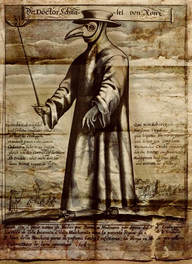 Let's set the stage using a little history, however, bear in mind, the seat of Mystery Babylon has been London since the inception of the Reformation.... 'The Great Plague 1665 – the Black Death by Ben Johnson In two successive years of the 17th century London suffered two terrible disasters. In the spring & summer of 1665 an outbreak of Bubonic Plague spread from parish to parish until thousands had died & the huge pits dug to receive the bodies were full. In 1666 the Great Fire of London destroyed much of the centre of London........ The plague started in the East, possibly China, & quickly spread through Europe. Whole communities were wiped out & corpses littered the streets as there was no one left to bury them..........It began in London in the poor, overcrowded parish of St. Giles-in-the-Field. It started slowly at first but by May of 1665, 43 had died. In June 6137 people died, in July 17036 people & at its peak in August, 31159 people died. In all, 15% of the population perished during that terrible summer. Incubation took a mere four to six days & when the plague appeared in a household, the house was sealed, thus condemning the whole family to death! These houses were distinguished by a painted red cross on the door & the words, ‘Lord have mercy on us’. At night the corpses were brought out in answer to the cry,’ Bring out your dead’, put in a cart & taken away to the plague pits. One called the Great Pit was at Aldgate in London & another at Finsbury Fields. The King, Charles II and his Court left London & fled to Oxford. Those people who could sent their families away from London during these months, but the poor had no recourse but to stay. In his diary, Samuel Pepys gives a vivid account of the empty streets in London, as all who could had left in an attempt to flee the pestilence. It was believed that holding a posy of flowers to the nose kept away the plague & to this day judges are still given a nose-gay to carry on ceremonial occasions as a protection against the plague! A song about the plague is still sung by children. ‘Ring-a-ring of roses‘ describes in great detail the symptoms of the plague & ends with ‘All fall down’. The last word, ‘dead’, is omitted today. The plague spread to many parts of England. York was one city badly affected............'  '.......The Great Fire of London by Ben Johnson The people of London who had managed to survive the Great Plague in 1665 must have thought that the year 1666 could only be better, & couldn’t possibly be worse! Poor souls… they could not have imagined the new disaster that was to befall them in 1666. A fire started on September 2nd in the King’s bakery in Pudding Lane near London Bridge. Fires were quite a common occurrence in those days & were soon quelled. Indeed, when the Lord Mayor of London, Sir Thomas Bloodworth was woken up to be told about the fire, he replied “Pish! A woman might piss it out!”.......The fire soon took hold: 300 houses quickly collapsed & the strong east wind spread the flames further, jumping from house to house. The fire swept through the warren of streets lined with houses, the upper stories of which almost touched across the narrow winding lanes. Efforts to bring the fire under control by using buckets quickly failed. Panic began to spread through the city. As the fire raged on, people tried to leave the city & poured down to the River Thames in an attempt to escape by boat. Absolute chaos reigned, as often happens today, as thousands of ‘sightseers’ from the villages came to view the disaster. Samuel Pepys & John Evelyn, the diarists, both gave dramatic, first-hand accounts of the next few days. Samuel Pepys, who was a clerk of the Privy Seal, hurried off to inform King Charles II. The King immediately ordered that all the houses in the path of the fire should be pulled down to create a ‘fire-break’. This was done with hooked poles, but to no avail as the fire outstripped them! By the 4th September half of London was in flames........... Only one fifth of London was left standing! Virtually all the civic buildings had been destroyed as well as 13,000 private dwellings, but amazingly only six people had died.......In the immediate aftermath of the fire, a poor demented French watchmaker called (Lucky) Hubert, confessed to starting the fire deliberately: justice was swift & he was rapidly hanged. It was sometime later however that it was realised that he couldn’t have started it, as he was not in England at the time! Although the Great Fire was a catastrophe, it did cleanse the city. The overcrowded & disease ridden streets were destroyed & a new London emerged. A monument was erected in Pudding Lane on the spot where the fire began & can be seen today, where it is a reminder of those terrible days in September 1666....... Sir Christopher Wren was given the task of re-building London, & his masterpiece St. Paul’s Cathedral was started in 1675 & completed in 1711. In memory of Sir Christopher there is an inscription in the Cathedral, which reads, “Si Monumentum Requiris Circumspice”. – “If you seek his monument, look round”. - http://www.historic-uk.com Anyone smell a rat?? I bet Thoth Hermes did with that beak. Anyhow, another chief planner of.....sorry, after the disasters was Robert Hooke, 'He was at one time simultaneously the curator of experiments of the Royal Society & a member of its council, Gresham Professor of Geometry & a Surveyor to the City of London after the Great Fire of London, in which capacity he appears to have performed more than half of all the surveys after the fire. He was also an important architect of his time'. Like Hooke, Diarists Samuel Pepys, John Evelyn & Sir Christopher Wren were members of the Royal Society. The following excerpt is taken from my 'How The East Was Won' Blog; '1660 was the year of the Royal Society’s foundation. It was also the year in which Charles II granted a charter to the “Royal Adventurers into Africa”, an organisation who would trade in gold, wood, ivory, as well as slaves. The Royal Adventurers were often regarded as a ‘sister’ society to the Royal Society. Indeed, many institutions & companies at this time were investing in the profits of newly opened trade with America, Africa & Asia. A complete list of the 30 persons named in the Charter shows 11 members already associated with the Society, many of whom would become Fellows in the following years. Similarly, the Royal African Company – which would replace the Adventurers in 1672 – featured many more who were, or would become, Fellows – including Sir Joseph Williamson FRS, who would become President of the Royal Society in 1677. The Society’s first substantial endowment, of 1,300 pounds, was made in the Royal Africa & East India Companies, both of whom were involved in the slave trade. A number of Fellows of the Royal Society were involved in these organisations, including Paul Neile FRS, while Jeremy Sambrooke & Sir John Lawrence were Commissioners of the East India Company.' https://royalsociety.org/topics-policy/diversity-in-science/black-history/slavery/ The Encyclopaedia Britannica (1961) however predates the Royal Society' beginnings to the mid 1640's, '.....as early as 1645 weekly meetings were held in London of "diverse & worthy persons"....& there can be little doubt that this gathering of philosophers is identical to the "Invisible College" of which Robert Boyle speaks'. Manly Hall goes much further & connects it to the Knights Templar; https://youtu.be/_7jPhcjBnc8 Unsurprisingly, Baigent, Leigh & Lincoln then make these correlations; 'There is no concrete evidence that this secret society was the Prieure de Sion, but [Robert] Boyle, according to the “Prieure documents’, succeeded Andrea as Sion’s Grand Master. During Cromwell’s Protectorate, these dynamic minds, both English & European, formed what Boyle in a deliberate echo of the “Rosicrucian’ manifestos [1614-16] called an ‘invisible college’. & with the restoration of the monarchy in 1660, the ‘invisible college’ became the Royal Society” with the Stuart ruler, Charles II, as its patron & sponsor. Virtually all the Royal Society’s founder members were Freemasons. One could reasonably argue that the Royal Society itself, at least in its inception, was a Masonic institution derived, through Andrea’s Christian Unions, from the ‘invisible Rosicrucian brotherhood’. But this was not to be the culmination of the ‘underground stream’. On the contrary, it was to flow from Boyle to Sir Isaac Newton, listed as Sion’s next Grand Master, & thence into the complex tributaries of eighteenth-century Freemasonry.' Holy Blood Holy Grail (1982). Whats that you say Ben? The plague came from the east? 'One of the Company’s trading stations was established at Bombay on the west coast of the Indian sub-continent. It had originally been founded by the Portuguese but transferred to Charles II in 1661 as part of the dowry of Catherine of Braganza & rented to the East India Company for ten pounds per year.' - http://www.thehistoryoflondon.co.uk/the-east-india-company/ Strange how a watchmaker was initially said to have been the culprit for The Great Fire, reminding one of the 'Great' conflagration of the Reformation, begun (ostensibly) by a member of the Watchmakers Guild in Germany, whose insignia was a rose & cross. Seal of Martin Luther I'm surprised the Jews didn't get the blame for this one as well, maybe they will in time, but then & there may have been just a little too much to swallow, as they'd only been allowed back into England ten years previous to the Plague after centuries of exile....... 'This is why Alchemy says you have to destroy the outer forms of things, you have to calcinate them, you have to burn them or corrupt them or destroy them until nothing of the body remains but ashes' - Manly Hall. Maybe it was the God of the Jews?? As 1666 was a portentous year & two huge comets were witnessed over London shortly prior to the 'Great' events to come. Or perhaps men had no further need of such superstitions, after all, this was the eve of the Enlightenment & besides, the members of the Royal Society were astronomers; '& he saith unto me, The waters which thou sawest, where the whore sitteth, are peoples, & multitudes, & nations, & tongues. & the ten horns which thou sawest upon the beast, these shall hate the whore, & shall make her desolate & naked, & shall eat her flesh, & burn her with fire. For God hath put in their hearts to fulfil his will, & to agree, & give their kingdom unto the beast, until the words of God shall be fulfilled. & the woman which thou sawest is that great city, which reigneth over the kings of the earth.' - http://biblehub.com/kjv/revelation/17.htm 'The second [Rosicrucian] Manifesto [early 17th Cen] repeats the message of the first, though with even greater fervour & intensity. A powerful prophetical & apocalyptic note sounds through it, the end is at hand, new stars foretelling wonders have appeared, the great reformation is to be a millennium' - Frances Yates 'The Rosicrucian Enlightenment' (1972). 'Millennialism, also called millenarianism or chiliasm, the belief, expressed in the book of Revelation to John, the last book of the New Testament, that Christ will establish a 1,000-year reign of the saints on earth (the millennium) before the Last Judgment.' britannica.com 'The forces which are working out the great scheme of perfect happiness, taking no account of incidental suffering, exterminate such sections of mankind as stand in their way, with the same sternness that they exterminate beasts of prey & herds of useless ruminants.' - Herbert Spencer (English Philosopher 1820 –1903)
0 Comments
Leave a Reply. |

|
|






